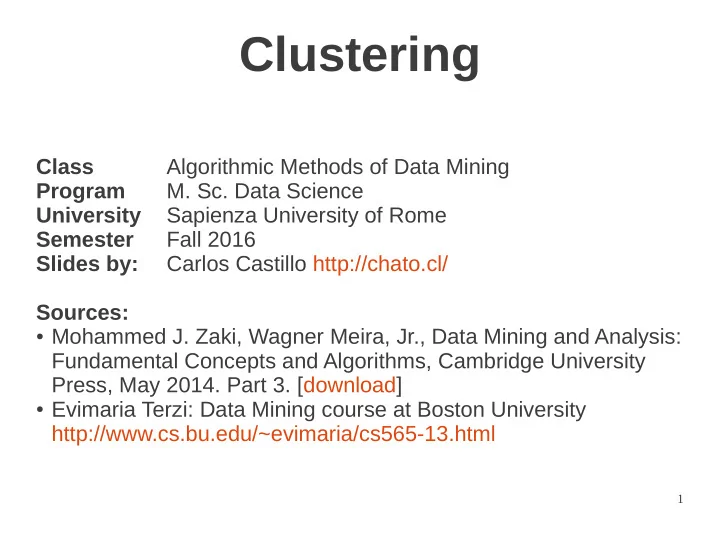

Clustering Class Algorithmic Methods of Data Mining Program M. Sc. Data Science University Sapienza University of Rome Semester Fall 2016 Slides by: Carlos Castillo http://chato.cl/ Sources: ● Mohammed J. Zaki, Wagner Meira, Jr., Data Mining and Analysis: Fundamental Concepts and Algorithms, Cambridge University Press, May 2014. Part 3. [download] ● Evimaria Terzi: Data Mining course at Boston University http://www.cs.bu.edu/~evimaria/cs565-13.html 1
Why these sizes? Why 3 groups instead of 2? 2
Clustering ● Given a set of elements (e.g. documents) ● Group similar elements together ● So that: – Inside a group, elements are similar – Across groups, elements are different 3
What is clustering? Inter -cluster distances are Intra -cluster maximized distances are minimized 4
Outliers • Outliers are objects that do not belong to any cluster or form clusters of very small cardinality cluster outliers • In some applications we are interested in discovering outliers, not clusters (outlier analysis) 5
Why do we cluster? ● Clustering results are used: – As a stand-alone tool to get insight into data distribution ● Visualization of clusters may unveil important information – As a preprocessing step for other algorithms ● Efficient indexing or compression often relies on clustering 6
Applications • Image Processing – Cluster images based on their visual content • Web – Cluster groups of users based on their access patterns on webpages – Cluster webpages based on their content • Bioinformatics – Cluster similar proteins together (similarity wrt chemical structure and/or functionality etc) • Many more… 7
8 http://dx.doi.org/10.1109/IVL.2000.853847
9 http://musicmachinery.com/2013/09/22/5025 /
http://www.nature.com/articles/srep00196/figures/ 10 2
Clustering questions ● How many clusters? – Given as input or determined by algorithm ● How good is a clustering? – Intra similarity, inter similarity, number of clusters ● Can an element belong to > 1 cluster? – Hard clustering vs Soft clustering 11
How many clusters? Boston University Slideshow Title Goes Here 12
Types of clusterings • Hierarchical • a set of nested clusters organized in a tree • Partitional • each object belongs in exactly one cluster 13
Hierarchical clustering • Produces a set of nested clusters organized as a hierarchical tree • Can be visualized as a dendrogram – A tree-like diagram that records the sequences of merges or splits
15 http://www.talkorigins.org/faqs/comdesc/phylo.html
Partitional algorithms • partition the n objects into k clusters • each object belongs to exactly one cluster • the number of clusters k is given in advance 16
Partitional clustering Boston University Slideshow Title Goes Here Original points Partitional clustering 17
Example: 1-dimensional clustering Communism Socialism Liberalism Conservatism Monarchism Fascism 18
Parenthesis: 2D political spectrum 19 http://www.termometropolitico.it/119350_dai-modelli-collocazione-nello-spazio-politico-test-per-elezioni-europee-2014.html
1 dimensional clustering 5 11 13 16 25 36 38 39 42 60 62 64 67 How would you cluster this data? Why? 20
1 dimensional clustering 5 11 13 16 25 36 38 39 42 60 62 64 67 What about now, how would you cluster? 21
Two very important metrics ● Minimum inter -cluster distance (should be large) ● Maximum intra -cluster distance (should be small) 22
1 dimensional clustering 5 11 13 16 25 36 38 39 42 60 62 64 67 5 11 13 16 25 36 38 39 42 60 62 64 67 5 11 13 16 25 36 38 39 42 60 62 64 67 Exercise: For each of these 3 clusterings: ● Compute minimum inter-cluster distance. ● Compute maximum intra-cluster distance. 23 http://chato.cl/2015/data_analysis/exercise-answers/clustering_exercise_01_answer.txt
Recommend
More recommend